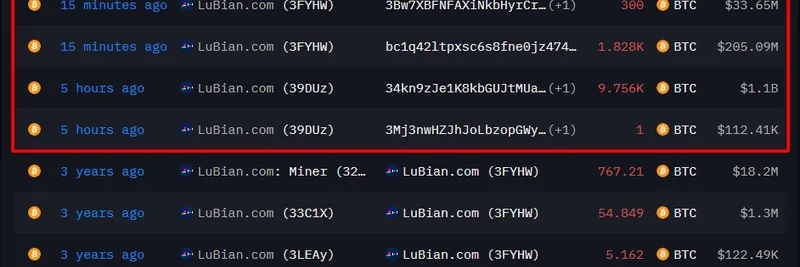Hey crypto enthusiasts, have you heard about the recent stir in the Bitcoin world? A long-dormant wallet associated with Lubian.com just moved a whopping 11,885 BTC, valued at around $1.34 billion. This comes right on the heels of the U.S. Department of Justice (DOJ) announcing their pursuit to seize over 127,000 BTC tied to what they're calling the "Lubian hack." It's a story packed with intrigue, involving global cybercrime networks and even forced-labor operations. Let's break it down step by step, keeping things simple and straightforward.
As shown in the on-chain data from Arkham Intelligence, recent transfers include chunks like 399 BTC and 1,828 BTC moved just minutes apart, with larger amounts shifted hours earlier. These movements mark the end of a three-year dormancy period for these wallets.
What is Lubian.com?
Lubian.com was once a prominent Bitcoin mining pool, operating primarily in China and Iran. At its peak, it controlled nearly 6% of the global Bitcoin hash rate—that's the computational power used to secure the network and mine new coins. Mining pools like Lubian allow individual miners to combine their resources for better chances of earning rewards. However, Lubian vanished from the scene in February 2021, shortly after a major incident that rocked its operations.
The 2020 "Hack" That Started It All
Back in December 2020, around 127,426 BTC (worth about $3.5 billion at the time) were reportedly stolen from Lubian's wallets. The culprit? A vulnerability in the algorithm used to generate cryptographic keys, which made them easy to crack through brute-force attacks. Think of it like using a weak password on your bank account—hackers could guess their way in.
In a desperate bid to recover the funds, Lubian sent hundreds of small transactions totaling over $40,000 to the hacker's addresses, each embedded with pleas like "Please return our funds, we'll pay a reward." Despite these efforts, the coins sat untouched for years, leading many to speculate about the nature of the theft.
Enter the Prince Group: From Scams to Seizures
Fast forward to today, and the plot thickens. The DOJ's recent announcement on October 14, 2025, reveals that these "stolen" Bitcoins are linked to the Prince Group, a Cambodian conglomerate accused of running forced-labor scam compounds. These operations, often called "pig butchering" scams, involve luring victims into fake romantic relationships or investment opportunities, only to fleece them through fraudulent crypto schemes.
According to blockchain analysis from Elliptic, Lubian was actually part of Prince Group's money-laundering network. The mining operations generated "clean" Bitcoin, dissociated from criminal proceeds, to wash dirty money. Prince Group's chairman, Chen Zhi, has been indicted for wire fraud and money laundering, with the seized 127,271 BTC—now valued at a staggering $15 billion—traced back to addresses he controlled.
Interestingly, some experts question if the 2020 theft was genuine or a staged event to further obfuscate the funds' origins. Either way, this marks the largest cryptocurrency forfeiture in U.S. history.
Recent Wallet Movements and DOJ's Move
While the bulk of the funds were moved to new wallets in June and July 2024 (now under DOJ custody), the latest transfers spotted on October 15, 2025, involve smaller but still significant amounts from Lubian-labeled addresses. This activity, highlighted in the original tweet by OnchainLens, suggests ongoing adjustments or perhaps attempts to liquidate portions amid the seizure proceedings.
The DOJ's action not only boosts the U.S. government's Bitcoin reserves but also sends a strong message about cracking down on international cybercrime networks that exploit blockchain for illicit gains.
Implications for Meme Tokens and the Broader Crypto Ecosystem
Now, you might be wondering: What does this have to do with meme tokens? Well, pig butchering scams often target unsuspecting investors with promises of high returns on trendy assets like meme coins. These operations prey on the hype surrounding tokens built on communities and viral trends, turning fun investments into nightmares.
This case underscores the importance of blockchain transparency—tools like on-chain analytics helped uncover these connections. For meme token enthusiasts, it's a reminder to stay vigilant: Research projects thoroughly, avoid unsolicited investment advice, and use reputable platforms. As the crypto space evolves, stories like Lubian's highlight how intertwined legitimate tech is with shady dealings, pushing for better security and regulations.
In the end, this saga is a fascinating glimpse into the underbelly of crypto. Whether you're a Bitcoin maximalist or a meme coin degen, keeping an eye on such developments can help you navigate the volatile waters of blockchain. What are your thoughts on this? Drop a comment below!



